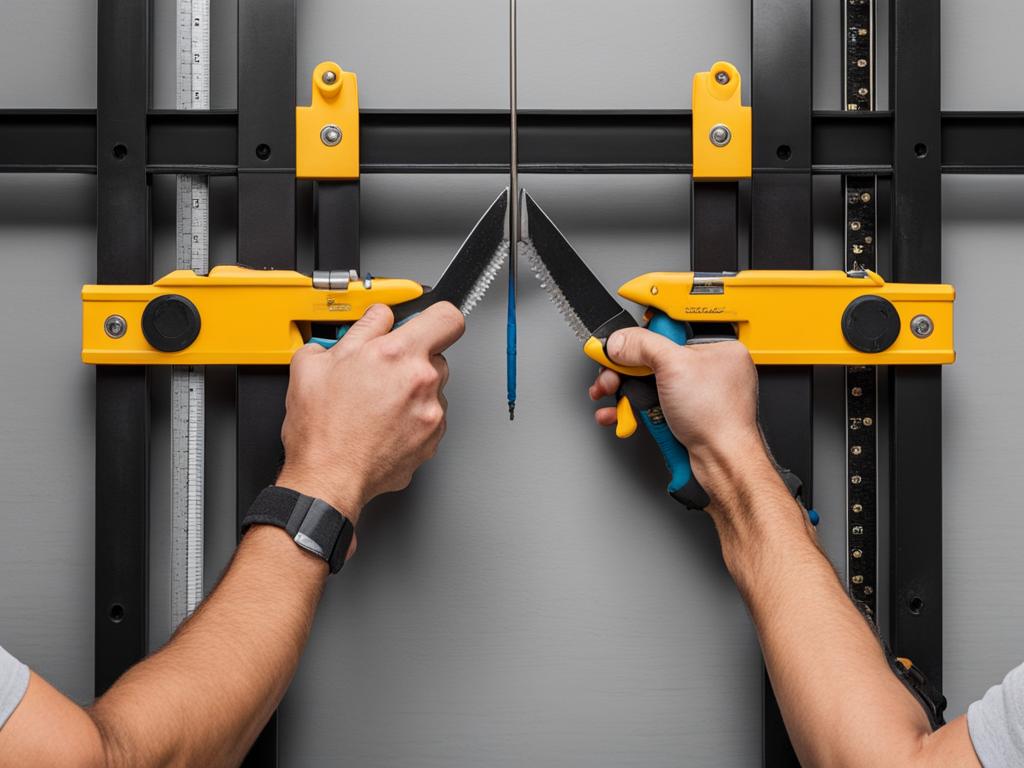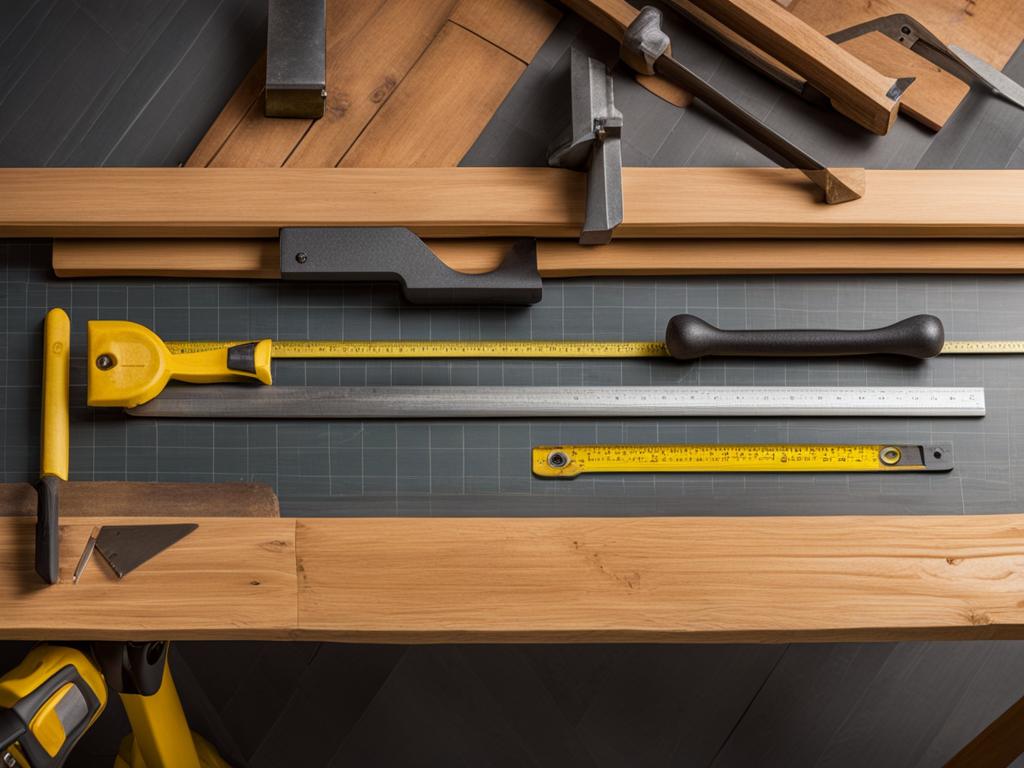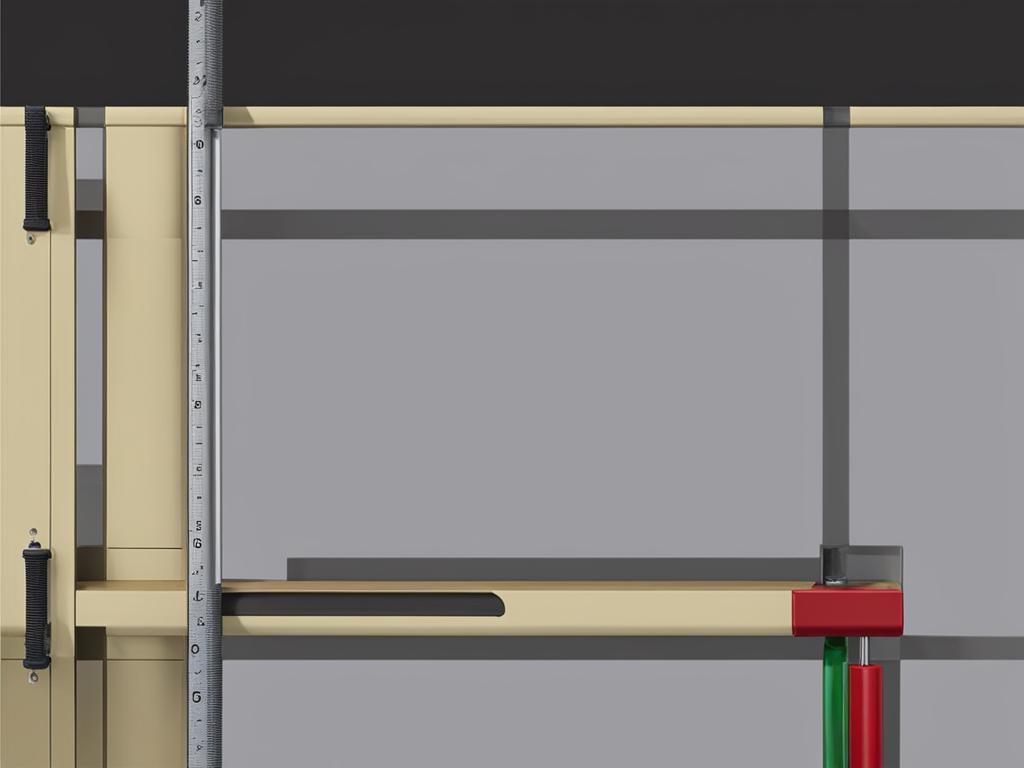In construction, it is crucial to understand the differences between plumb and level. While both terms refer to straightness, they have different relationships to the horizon. Level refers to straightness side to side (horizontal), whereas plumb measures straightness up and down (vertical). This distinction is significant for ensuring accuracy in building projects.
Key Takeaways:
- Plumb and level are terms used to describe straightness in construction.
- Level refers to horizontal straightness, while plumb refers to vertical straightness.
- Using the appropriate tools and techniques for plumb and level is essential for accurate measurements.
- Plumb and level are crucial for maintaining structural integrity and aesthetic appeal in building projects.
- Understanding the differences between plumb and level helps ensure precise and high-quality construction results.
What is Level?
Level refers to a perfectly horizontal line. When something is level, it is parallel to the horizon. In construction, a spirit level or bubble level is used to determine if something is horizontally straight. This tool utilizes a vial of liquid with an air bubble that runs parallel to the body of the tool. When the tool is level with the earth, the bubble is in the middle of the vial. Using a level is essential for achieving horizontal straightness in construction projects.
| Type of Level Tool | Features |
|---|---|
| Spirit Level |
|
| Bubble Level |
|
What is Plumb?
In construction, understanding the concept of plumb is essential for ensuring vertical straightness. When something is plumb, it runs perpendicular to the horizon, creating a right angle. To determine if an object or surface is plumb, various tools can be used, such as a plumb bob or a spirit level. These tools help achieve accurate vertical measurements and ensure that structures are straight and aligned correctly.
A plumb bob is a simple yet effective tool frequently employed by construction professionals. It consists of a weight, usually made of metal, attached to a string or line. When the plumb bob is suspended from a height, the weight aligns with the force of gravity and creates a vertical line. By observing the alignment of the plumb bob relative to reference points, builders can accurately determine if an object is plumb or not.
Another tool commonly used for measuring plumbness is the spirit level. While primarily designed to determine horizontal straightness, spirit levels can also be used to assess vertical alignment. By positioning the spirit level against a surface and observing the position of the bubble within the level’s vial, builders can ascertain if the surface is plumb. If the bubble is precisely centered within the vial, the surface is deemed plumb; if not, adjustments can be made to achieve the desired vertical straightness.
Plumb lines are another method for assessing plumbness. A plumb line consists of a thread or string with a weight attached to one end, similar to a plumb bob. To use a plumb line, the weight is held against a reference point, such as a wall or structure, allowing the line to hang freely. The builder then checks if the line aligns perfectly vertically with the reference point, indicating plumbness. This technique is often relied upon in large-scale construction projects where accurately establishing verticality is crucial.
Using plumb tools such as plumb bobs, spirit levels, and plumb lines is vital to ensure vertical alignment and straightness in construction projects. By maintaining plumbness, builders can achieve precise measurements, avoid structural issues, and ultimately create robust and aesthetically pleasing structures.
Importance of Plumb and Level in Construction
In the world of construction, the concepts of plumb and level play a crucial role in achieving accurate and precise results. Whether you are building walls, installing doors and windows, or constructing frames, ensuring that everything is plumb and level is of utmost importance.
Using plumb and level measurements guarantees that your structures are straight, well-aligned, and visually appealing. It ensures that your walls stand tall and vertical, your doors and windows operate smoothly, and your floors are even. Without proper attention to plumb and level, you run the risk of slanted structures, uneven surfaces, and operational issues that can impact the overall functionality and aesthetics of your project.
Plumb and level tools and techniques provide construction professionals with the means to measure and create straight structures with precision. By utilizing these tools, you can achieve accuracy and maintain the highest standards of quality in your construction projects.
The Benefits of Using Plumb and Level Tools
- Accurate Measurements: Plumb and level tools enable you to take precise measurements, ensuring that your structures are straight and properly aligned.
- Visual Appeal: Straight walls, level floors, and well-aligned doors and windows contribute to the visual appeal and overall quality of your construction project.
- Operational Efficiency: Properly aligned doors and windows operate smoothly without any sticking or binding, enhancing the functionality of your buildings.
- Structural Integrity: Plumb and level structures provide better stability and structural integrity, minimizing the risk of uneven settling or structural problems over time.
- Trade Standards: Plumb and level measurements are essential to meet industry standards, ensuring the compliance and safety of your construction projects.
Measuring Plumb and Level in Construction
There are various tools available to measure plumb and level in construction. Some commonly used tools include:
| Tool | Usage |
|---|---|
| Spirit Level | Utilizes a liquid-filled vial with an air bubble to determine if something is level or plumb. It provides accurate measurements for both horizontal and vertical alignment. |
| Water Level | Uses plastic tubing and water to measure level over longer distances. This tool is ideal for establishing a level reference point across large areas. |
| Laser Level | Utilizes a laser beam to check alignment and measure both level and plumb. It offers high precision and is suitable for various construction applications. |
By incorporating these tools into your construction processes, you can confidently measure and achieve plumb and level in your projects, ensuring the highest standards of accuracy and quality throughout.
Tools for Measuring Plumb and Level
When it comes to achieving accurate measurements of plumb and level in construction, several essential tools are available to professionals. These tools play a crucial role in ensuring the straightness and alignment of various elements in building projects. Let’s explore some of the commonly used tools:
Spirit Levels (Bubble Levels)
The spirit level, also known as a bubble level, is a widely used instrument for measuring both plumb and level. It consists of a liquid-filled vial with an air bubble inside. By observing the position of the bubble in the vial, professionals can determine whether a surface is level or plumb. Spirit levels are available in various lengths and can be handheld or mounted on other tools for added convenience and versatility.
Water Levels
Water levels offer an alternative method for measuring level over longer distances. This tool employs a simple yet effective principle: the use of water and plastic tubing. By positioning one end of the plastic tubing at a designated reference point, such as a benchmark or starting point, and then placing the other end at the desired measurement location, professionals can observe the water level in both ends of the tubing. This technique allows for accurate level measurements even when significant variations in terrain or distance come into play.
Laser Levels
In recent years, laser levels have gained popularity in the construction industry due to their convenience and precision. Laser levels utilize a laser beam to check the alignment of various surfaces and can measure both plumb and level with high accuracy. These tools often come with additional features such as self-leveling capabilities and the ability to project laser lines over long distances. Laser levels are particularly useful in large-scale construction projects where speed and accuracy are of utmost importance.
“Using the right tools for measuring plumb and level is crucial in construction to ensure the accuracy and integrity of the final result. Spirit levels, water levels, and laser levels are all indispensable instruments in a builder’s toolkit.”
By leveraging these tools, construction professionals can confidently measure and adjust plumb and level elements in their projects, guaranteeing the straightness and alignment necessary for high-quality construction.

Summary
Plumb and level tools are essential for achieving accurate measurements in construction. Spirit levels, water levels, and laser levels are three valuable instruments that professionals rely on. Whether it’s ensuring vertical alignment or determining horizontal straightness, these tools provide the precision needed to meet the highest standards in construction.
Square and True in Construction
In addition to plumb and level, square and true are important concepts in construction. Square refers to perfect corners, where two perpendicular lines create a right angle. To ensure square corners, tools such as steel squares or framing squares can be used to measure and mark precise 90-degree angles. True construction means that everything is lined up correctly, with straight vertical and horizontal lines and perfectly square corners. Achieving square and true construction is crucial for maintaining structural integrity and aesthetic appeal in building projects.
When it comes to constructing buildings, ensuring that corners are square and everything is true is essential for a successful project. Square corners not only contribute to the overall stability and strength of a structure but also ensure proper alignment and functionality of doors, windows, and other elements.
One of the most common tools used to measure and achieve square corners is the steel square or framing square. These tools are designed with a 90-degree angle, allowing builders to check for precise right angles at corner joints. By placing the square against two intersecting walls or surfaces, it becomes easy to determine whether the corners are perfectly square or if adjustments are needed.
To measure squareness accurately, here’s how to use a steel square or framing square:
- Place one arm of the square flush against one wall and the other arm against the adjacent wall.
- Check if the square’s edge aligns perfectly with both walls.
- If the edges align perfectly, the corner is square. If not, adjustments need to be made.
Creating true construction goes beyond just square corners. It involves ensuring that all vertical and horizontal lines are straight and aligned correctly. This includes checking for levelness (horizontal straightness) and plumbness (vertical straightness) using tools such as levels and plumb bobs.
“Achieving square and true construction is crucial for maintaining structural integrity and aesthetic appeal in building projects.”
Properly aligning walls, floors, and other structural elements not only improves the appearance of a building but also contributes to its overall functionality and longevity. Straight and square construction helps prevent issues such as uneven floors, doors that don’t close properly, or walls that lean over time.
Table:
| Importance of Square and True Construction | Benefits |
|---|---|
| Structural Integrity | Ensures stability and strength |
| Functionality | Proper alignment of doors, windows, and other elements |
| Aesthetics | Enhances the visual appeal of the building |
| Longevity | Prevents issues such as uneven floors and leaning walls |
By prioritizing square and true construction techniques, builders can create structures that stand the test of time in both functionality and appearance. Whether it’s measuring square corners with steel squares or ensuring straight lines with levels, accuracy and attention to detail are key.
Tools and Techniques for Achieving Square and True Construction
To achieve square and true construction, construction professionals utilize various tools and techniques. These tools are specifically designed to ensure accurate measurements, check for square corners, and create perfectly straight lines. By leveraging these tools, builders can achieve structurally sound and aesthetically pleasing projects. Here are some of the key tools and techniques:
1. Steel Squares, Framing Squares, and T-Squares
Steel squares, framing squares, and T-squares are commonly used tools for measuring and marking 90-degree angles. These tools provide precise measurements and allow builders to create square corners with accuracy. By aligning the square against the edges of a structure, construction professionals can ensure that their corners are perfectly square.
2. The 3-4-5 Triangle Method
The 3-4-5 triangle method is a simple yet effective technique for checking for square corners. To apply this method, builders measure three units on one side of a corner, four units on the other side, and five units along the diagonal connecting the two points. If the measurements are accurate, the corner will be perfectly square.
3. Straight Boards and Levels
Ensuring straight lines in construction is crucial for achieving square and true construction. Builders can use straight boards and levels to create straight reference lines for measurements. By aligning a straight board against a surface and using a level to check for horizontal or vertical alignment, builders can ensure straight lines in their construction projects.
By utilizing these tools and techniques, construction professionals can achieve square and true construction. This level of precision leads to structurally stable and visually appealing projects. Whether it’s measuring and marking 90-degree angles, checking for square corners, or creating straight lines, these tools play a vital role in achieving accurate and high-quality construction results.

Conclusion
In the world of construction and carpentry, the importance of understanding and utilizing plumb and level cannot be overstated. These fundamental concepts are the building blocks of accurate measurements and straightness in building projects. By using the right tools and techniques, such as spirit levels, water levels, and laser levels, construction professionals can ensure that their structures are perfectly plumb, level, square, and true.
When carpenters focus on achieving plumb and level measurements, they create structures that not only look aesthetically pleasing but also function seamlessly. Walls, doors, windows, and frames that are straight and properly aligned prevent operational issues and ensure the overall quality of a project. By paying attention to the details and using plumb and level tools, construction professionals can guarantee the highest level of precision and accuracy in their work.
So, whether you’re building a small bookshelf or a large-scale construction project, always remember the significance of plumb and level. These concepts act as guides and foundations for producing outstanding craftsmanship. By incorporating plumb and level into your carpentry work, you not only achieve accurate measurements but also elevate the quality and integrity of your constructions. So, grab your level, double-check your plumb, and start building with confidence!
FAQ
What is the difference between plumb and level?
Plumb refers to vertical straightness, while level refers to horizontal straightness.
What does it mean to be level?
Being level means being perfectly horizontal and parallel to the horizon.
What does it mean to be plumb?
Being plumb means being perfectly vertical and perpendicular to the horizon.
How are plumb and level important in construction?
Plumb and level measurements ensure straight and properly aligned structures.
What tools are used for measuring plumb and level?
Tools such as spirit levels, water levels, and laser levels are commonly used.
What is the importance of square and true in construction?
Square ensures perfect corners, while true means everything is aligned correctly.
What tools and techniques can be used for achieving square and true construction?
Steel squares, framing squares, T-squares, and the 3-4-5 triangle method can be used.
How important are plumb and level in carpentry?
Plumb and level are essential for accurate measurements in carpentry projects.
